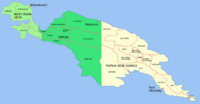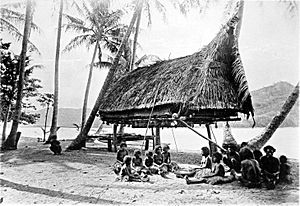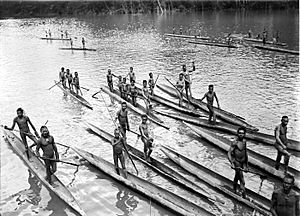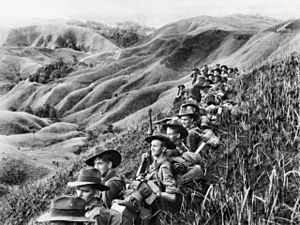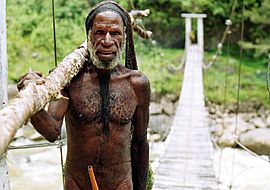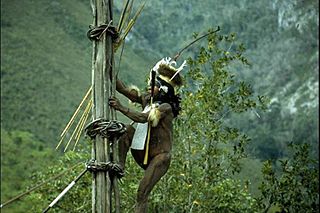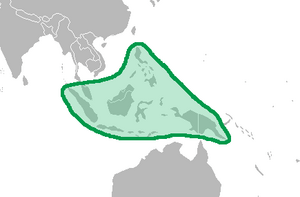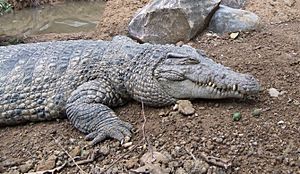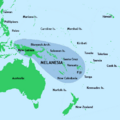New Guinea facts for kids
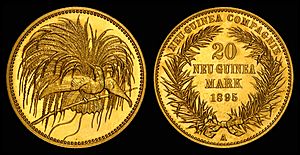
New Guinea is a big island north of Australia. It is the second largest island in the world.
On the east side of New Guinea is the country Papua New Guinea. On the west side of the island are the Indonesian provinces of Papua and West Irian Jaya.
About 6.9 million people live on the island.
New Guinea is also very important for its nature and biology, because there are many different animals.
Contents
History
Early history
The first inhabitants of New Guinea arrived at least 50,000 years ago, having travelled through the south-east Asian peninsula. These first inhabitants, from whom the Papuan people are probably descended, adapted to the range of ecologies and, in time, developed one of the earliest known agricultures. Remains of this agricultural system, in the form of ancient irrigation systems in the highlands of Papua New Guinea, are being studied by archaeologists. This work is still in its early stages, so there is still uncertainty as to precisely what crop was being grown, or when/where agriculture arose. Sugar cane was cultivated for the first time in New Guinea around 6000 BC.
The gardens of the New Guinea Highlands are ancient, intensive permacultures, adapted to high population densities, very high rainfalls (as high as 10,000 mm/yr (400 in/yr)), earthquakes, hilly land, and occasional frost. Complex mulches, crop rotations and tillages are used in rotation on terraces with complex irrigation systems. There is evidence that New Guinea gardeners invented crop rotation well before western Europeans. A unique feature of New Guinea permaculture is the silviculture of Casuarina oligodon, a tall, sturdy native ironwood tree, suited to use for timber and fuel, with root nodules that fix nitrogen. Pollen studies show that it was adopted during an ancient period of extreme deforestation.
In more recent millennia, another wave of people arrived on the shores of New Guinea. These were the Austronesian people, who had spread down from Taiwan, through the South-east Asian archipelago, colonising many of the islands on the way. The Austronesian people had technology and skills extremely well adapted to ocean voyaging and Austronesian language speaking people are present along much of the coastal areas and islands of New Guinea. These Austronesian migrants are considered the ancestors of most people in insular Southeast Asia, from Sumatra and Java to Borneo and Sulawesi, as well as coastal new Guinea.
Precolonial history
The western part of the island was in contact with kingdoms in other parts of modern-day Indonesia.
The Negarakertagama mentioned the region of Wanin in eastern Nusantara as part of Majapahit's tributary. This has been identified with the Onin Peninsula, part of the Bomberai Peninsula near the city of Fakfak.
The sultans of Tidore, in Maluku Islands, claimed sovereignty over various coastal parts of the island. During Tidore's rule, the main exports of the island during this period were resins, spices, slaves and the highly priced feathers of the bird-of-paradise. Sultan Nuku, one of the most famous Tidore sultans who rebelled against Dutch colonization, called himself "Sultan of Tidore and Papua", during his revolt in 1780s. He commanded loyalty from both Moluccan and Papuan chiefs, especially those of Raja Ampat Islands. Following Tidore's defeat, much of the territory it claimed in western part of New Guinea came under Dutch rule as part of Dutch East Indies.
European contact
The first European contact with New Guinea was by Portuguese and Spanish sailors in the 16th century. In 1526–27, the Portuguese explorer Jorge de Meneses saw the western tip of New Guinea and named it ilhas dos Papuas. In 1528, the Spanish navigator Álvaro de Saavedra also recorded its sighting when trying to return from Tidore to New Spain. In 1545, the Spaniard Íñigo Ortíz de Retes sailed along the north coast of New Guinea as far as the Mamberamo River, near which he landed on 20 June, naming the island 'Nueva Guinea'.
The first map showing the whole island (as an island) was published in 1600 and shows it as 'Nova Guinea'. In 1606, Luís Vaz de Torres explored the southern coast of New Guinea from Milne Bay to the Gulf of Papua including Orangerie Bay, which he named Bahía de San Lorenzo. His expedition also discovered Basilaki Island naming it Tierra de San Buenaventura, which he claimed for Spain in July 1606. On 18 October, his expedition reached the western part of the island in present-day Indonesia, and also claimed the territory for the King of Spain.
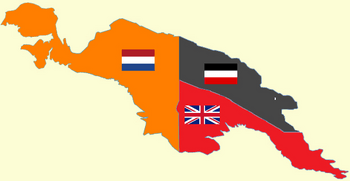
A successive European claim occurred in 1828, when the Netherlands formally claimed the western half of the island as Netherlands New Guinea. In 1883, following a short-lived French annexation of New Ireland, the British colony of Queensland annexed south-eastern New Guinea. However, the Queensland government's superiors in the United Kingdom revoked the claim, and (formally) assumed direct responsibility in 1884, when Germany claimed north-eastern New Guinea as the protectorate of German New Guinea (also called Kaiser-Wilhelmsland).
The first Dutch government posts were established in 1898 and in 1902: Manokwari on the north coast, Fak-Fak in the west and Merauke in the south at the border with British New Guinea. The German, Dutch and British colonial administrators each attempted to suppress the still-widespread practices of inter-village warfare and headhunting within their respective territories.
In 1905, the British government transferred some administrative responsibility over southeast New Guinea to Australia (which renamed the area "Territory of Papua"); and, in 1906, transferred all remaining responsibility to Australia. During World War I, Australian forces seized German New Guinea, which in 1920 became the Territory of New Guinea, to be administered by Australia under a League of Nations mandate. The territories under Australian administration became collectively known as The Territories of Papua and New Guinea (until February 1942).
Before about 1930, European maps showed the highlands as uninhabited forests. When first flown over by aircraft, numerous settlements with agricultural terraces and stockades were observed. The most startling discovery took place on 4 August 1938, when Richard Archbold discovered the Grand Valley of the Baliem River, which had 50,000 yet-undiscovered Stone Age farmers living in orderly villages. The people, known as the Dani, were the last society of its size to make first contact with the rest of the world.
World War II
Netherlands New Guinea and the Australian territories were invaded in 1942 by the Japanese. The Australian territories were put under military administration and were known simply as New Guinea. The highlands, northern and eastern parts of the island became key battlefields in the South West Pacific Theatre of World War II.
Papuans often gave vital assistance to the Allies, fighting alongside Australian troops, and carrying equipment and injured men across New Guinea. Approximately 216,000 Japanese, Australian and U.S. soldiers, sailors and airmen died during the New Guinea Campaign.
Since World War II
Following the return to civil administration after WW2, the Australian section was known as the Territory of Papua-New Guinea from 1945 to 1949 and then as Territory of Papua and New Guinea. Although the rest of the Dutch East Indies achieved independence as Indonesia on 27 December 1949, the Netherlands regained control of western New Guinea.
During the 1950s, the Dutch government began to prepare Netherlands New Guinea for full independence and allowed elections in 1959; the elected New Guinea Council took office on 5 April 1961. The Council decided on the name of West Papua for the territory, along with an emblem, flag, and anthem to complement those of the Netherlands.
On 1 October 1962, the Dutch handed over the territory to the United Nations Temporary Executive Authority, until 1 May 1963, when Indonesia took control. The territory was renamed West Irian and then Irian Jaya. In 1969, Indonesia, under the 1962 New York Agreement, organised a referendum named the Act of Free Choice, in which hand picked Papuan tribal elders reached a consensus to continue the union with Indonesia.
There has been resistance to Indonesian integration and occupation, both through civil disobedience (such as Morning Star flag raising ceremonies) and via the formation of the Organisasi Papua Merdeka (OPM, or Free Papua Movement) in 1965. Amnesty International has estimated more than 100,000 Papuans, one-sixth of the population, have died as a result of government-sponsored violence against West Papuans.
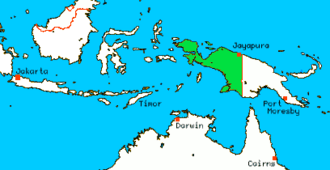
From 1971, the name Papua New Guinea was used for the Australian territory. On 16 September 1975, Australia granted full independence to Papua New Guinea.
In 2000, Irian Jaya was formally renamed "The Province of Papua" and a Law on Special Autonomy was passed in 2001.
People
The current population of the island of New Guinea is about eleven million. Many believe human habitation on the island dates to as early as 50,000 BC, and first settlement possibly dating back to 60,000 years ago has been proposed.
The island is presently populated by almost a thousand different tribal groups and a near-equivalent number of separate languages, which makes New Guinea the most linguistically diverse area in the world. Ethnologue's 14th edition lists 826 languages of Papua New Guinea and 257 languages of Irian Jaya, total 1073 languages, with 12 languages overlapping. They fall into one of two groups, the Papuan languages and the Austronesian languages.
Current evidence indicates that the Papuans (who constitute the majority of the island's peoples) are descended from the earliest human inhabitants of New Guinea. These original inhabitants first arrived in New Guinea at a time (either side of the Last Glacial Maximum, approx 21,000 years ago) when the island was connected to the Australian continent via a land bridge, forming the landmass known as Sahul.
These peoples had made the (shortened) sea-crossing from the islands of Wallacea and Sundaland (the present Malay Archipelago) by at least 40,000 years ago, subsequent to the dispersal of peoples from Africa (circa) 50,000 – 70,000 years ago.
The ancestral Austronesian peoples are believed to have arrived considerably later, approximately 3,500 years ago, as part of a gradual seafaring migration from Southeast Asia, possibly originating in Taiwan. Austronesian-speaking peoples colonized many of the offshore islands to the north and east of New Guinea, such as New Ireland and New Britain, with settlements also on the coastal fringes of the main island in places.
Human habitation of New Guinea over tens of thousands of years has led to a great deal of diversity, which was further increased by the later arrival of the Austronesians and the more recent history of European and Asian settlement through events like transmigration. About half of the 2.4 million inhabitants of Indonesian Papua are Javanese migrants.
Large areas of New Guinea are yet to be explored by scientists and anthropologists. The Indonesian province of West Papua is home to an estimated 44 uncontacted tribal groups.
Biodiversity and ecology
With some 786,000 km2 of tropical land—less than one-half of one percent (0.5%) of the Earth's surface—New Guinea has an immense biodiversity, containing between 5 and 10 percent of the total species on the planet. This percentage is about the same amount as that found in the United States or Australia.
A high percentage of New Guinea's species are endemic, and thousands are still unknown to science: probably well over 200,000 species of insect, between 11,000 and 20,000 plant species, and over 650 resident bird species. Most of these species are shared, at least in their origin, with the continent of Australia, which was until fairly recent geological times part of the same landmass (see Australia-New Guinea for an overview). The island is so large that it is considered 'nearly a continent' in terms of its biological distinctiveness.
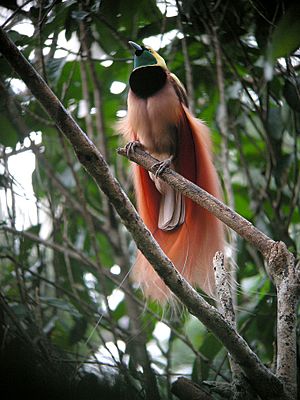
Biogeographically, New Guinea is part of Australasia rather than the Indomalayan realm, although New Guinea's flora has many more affinities with Asia than its fauna, which is overwhelmingly Australian.
Botanically, New Guinea is considered part of Malesia, a floristic region that extends from the Malay Peninsula across Indonesia to New Guinea and the East Melanesian Islands. The flora of New Guinea is a mixture of many tropical rainforest species with origins in Asia, together with typically Australasian flora. Typical Southern Hemisphere flora include the conifers Podocarpus and the rainforest emergents Araucaria and Agathis, as well as tree ferns and several species of Eucalyptus.
New Guinea has 284 species and six orders of mammals: monotremes, three orders of marsupials, rodents and bats; 195 of the mammal species (69%) are endemic. New Guinea has 578 species of breeding birds, of which 324 species are endemic. The island's frogs are one of the most poorly known vertebrate groups, totalling 282 species, but this number is expected to double or even triple when all species have been documented. New Guinea has a rich diversity of coral life and 1,200 species of fish have been found. Also about 600 species of reef-building coral—the latter equal to 75 percent of the world’s known total. The entire coral area covers 18 million hectares off a peninsula in northwest New Guinea.
Ecoregions
Terrestrial
According to the WWF, New Guinea can be divided into twelve terrestrial ecoregions:
- Central Range montane rain forests
- Central Range sub-alpine grasslands
- Huon Peninsula montane rain forests
- New Guinea mangroves
- Northern New Guinea lowland rain and freshwater swamp forests
- Northern New Guinea montane rain forests
- Southeastern Papuan rain forests
- Southern New Guinea freshwater swamp forests
- Southern New Guinea lowland rain forests
- Trans Fly savanna and grasslands
- Vogelkop montane rain forests
- Vogelkop-Aru lowland rain forests
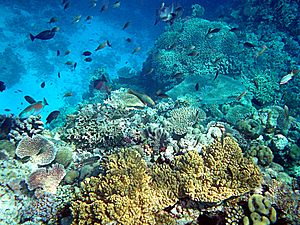
Freshwater
The WWF and Nature Conservancy divide New Guinea into five freshwater ecoregions:
- Vogelkop–Bomberai
- New Guinea North Coast
- New Guinea Central Mountains
- Southwest New Guinea–Trans-Fly Lowland
- Papuan Peninsula
Marine
The WWF and Nature Conservancy identify several marine ecoregions in the seas bordering New Guinea:
- Papua
- Bismarck Sea
- Solomon Sea
- Southeast Papua New Guinea
- Gulf of Papua
- Arafura Sea
Images for kids
-
New Guinea located in relation to Melanesia
See also
 In Spanish: Nueva Guinea para niños
In Spanish: Nueva Guinea para niños



